How to Pump a Car Tire Without a Pump: Is It Possible Using Handy Tools
Every single folk method of inflating a tire without a pump is inferior to a regular automotive compressor, even the lowest-performing one.
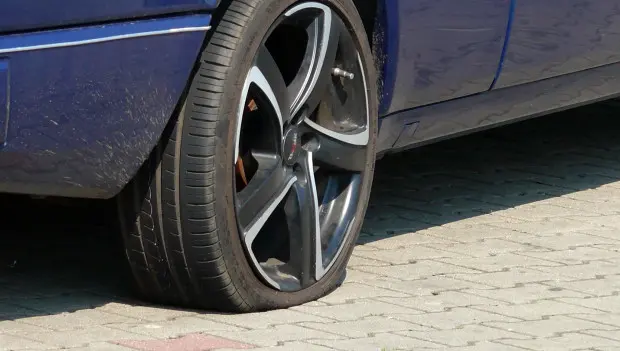
We have watched numerous YouTube videos and scrolled through millions of internet pages in search of these magical tips. We didn't try them ourselves, and dear readers, we do not recommend repeating the experience of the great DIYers. All these methods and tips are complete nonsense. It is better to call a tow truck or contact "roadside assistance" or "road service".
Nonetheless, we have taken the liberty to publish the senseless advice of the greats.
So, a long road can throw quite a few unpleasant surprises your way, one of which is a tire puncture. The situation becomes especially difficult for a motorist when there is no spare tire or automotive compressor. Theoretically, there are many ways to pump a tire without a pump, but not all of them are effective and can genuinely help in a difficult situation.
How to Inflate a Tire Without a Pump
It should be immediately noted that every single folk method of inflating a tire without a pump is inferior to a regular automotive compressor, even the lowest-performing one. Therefore, they should be used only as a last resort when there is no alternative. Some do not provide the needed result, while others are quite risky or require the fabrication of additional devices.
Inflation Using the Exhaust System
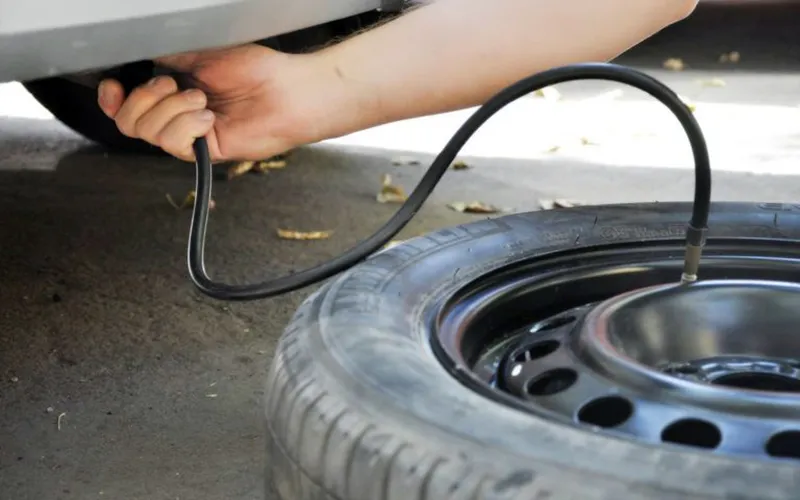
One effective method of inflation is using the car's exhaust gases. The exhaust system can provide pressure in the tire up to 2 atmospheres or more, which is sufficient to reach a service station or gas station where the tire can be repaired and inflated with regular air. The challenge lies in having a hose and adapters needed to transfer exhaust gases into the tire's interior and ensure the system's airtightness.
To inflate the tire, you need to connect a hose to the car's exhaust pipe and rev the engine. The main difficulty is ensuring sufficient airtightness at the connection between the hose and the exhaust pipe. Tape, washers, and bottle caps can help—anything that might be handy in such a situation.
Another drawback of this method is the possibility of damaging the catalytic converter or the exhaust system's flex pipe. Therefore, it should only be used as a last resort.
Transferring Air from Other Tires
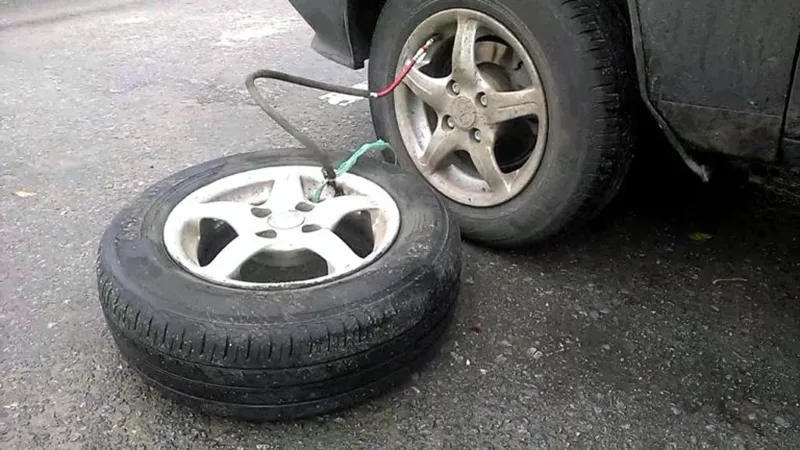
Another effective but complicated method is transferring air from other tires. The valve mechanism prevents air from escaping the tire. However, if you unscrew the core of an inflated tire, there's a risk of ending up with multiple flat tires.
Therefore, when using this method, you need to attach tips to the hose similar to those on a standard automotive compressor. You can also use an adapter that should be procured in advance. Once the hose is attached to the tire valves, the air from the inflated tire will flow into the flat one due to the pressure difference.
For inflation, it's better to use several inflated tires—this way, you can ensure approximately equal pressure in the tires, around 75% of what is required (1.5 to 1.8 bar in each).
Using a Fire Extinguisher
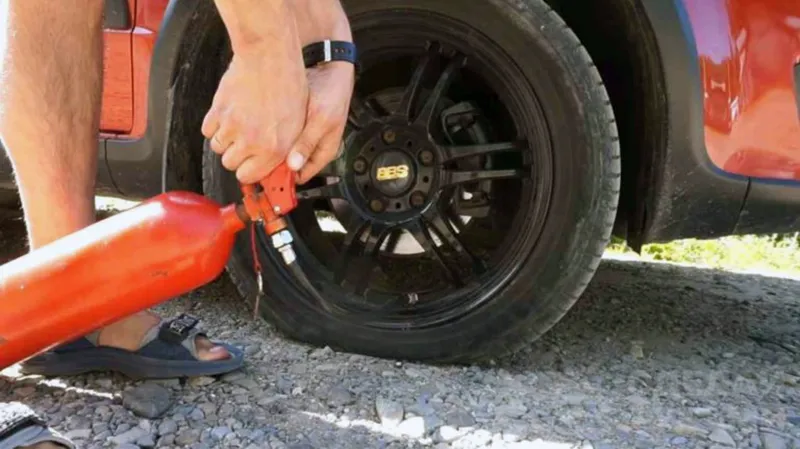
Inflating a tire with a fire extinguisher is another common method to solve the problem. Naturally, only a carbon dioxide (CO2) extinguisher is suitable, not a powder one. Since most average car owners typically have a powder extinguisher, this method is largely inapplicable.
If a suitable type of extinguisher is at hand, inflating the tire is quite simple. You need to connect the device’s nozzle to the valve using a hose. When pressing the extinguisher trigger, liquid carbon dioxide is released. Upon contact with air, it turns into a gaseous state and fills the tire’s interior quickly.
This method has a couple of drawbacks. The first is the intense cooling of the hose and extinguisher during the transition of carbon dioxide from liquid to gas. The second is the need to create a hose with an adapter to connect to the extinguisher.
Unreliable Methods
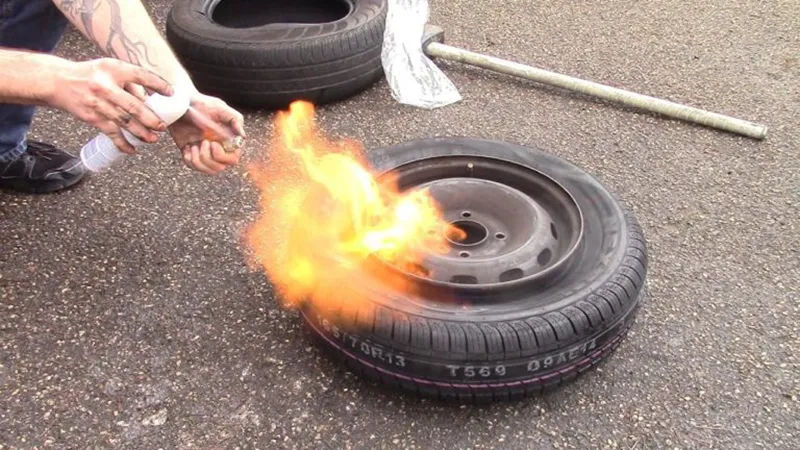
There are also rumors among motorists about other inflation methods, but all of them have critical drawbacks that prevent their use in real-world situations.
- Inflation using aerosol cans. The pressure in these can reach 2–2.5 atmospheres, which is quite sufficient for a car tire. An additional advantage is that they can be easily connected to the valve. The main problem lies in the tire’s internal volume, which is up to 25 liters. It takes several dozen cans to inflate the tire to even the minimal possible level.
- Inflation using explosion—a method involving the explosive power of the vapors from a flammable liquid, like gasoline, WD-40, or carburetor cleaner. Beyond the obvious fire hazard, this method does not deliver the required results—the pressure in the tire does not increase by more than 0.1–0.3 atmospheres.
- Inflation using the car's brake system. This requires draining the master cylinder reservoir and connecting the tire valve to its nozzle. Then, you need to press the brake pedal to pump air. To raise the tire pressure to even minimal levels requires a vast number of presses, rendering this method unsuitable.
- Inflation through turbocharging. Due to insufficient boost pressure in ordinary engines, this method is also unsuitable.
Folk methods of inflating a flat tire can help in an emergency situation on a country road. However, all of them either fail to provide adequate pressure, are dangerous, or are complicated to execute. Therefore, it is important to always carry a car pump—even the least effective one is more reliable than any of the alternative methods.
You may also be interested in the news:

Which Car Matches Your Zodiac Sign: A Guide for American Women
Your zodiac sign can guide more than just your choice of gemstones, dress colors, or lucky shopping days—it can also help you pick the perfect car!

Driving Modes — Eco, Sport, Snow and More: Is There Real Benefit for Americans Who Mostly Drive on Highways?
Most modern vehicles — from popular crossovers to luxury SUVs — feature a Drive Mode selector button or dial.

Vintage Toyota Land Cruiser Gets a Tundra Heart Transplant
Toyota dropped a modern twin-turbo V6 into an ‘80s Land Cruiser — and it’s nothing short of genius.

Rendered 1996 Chevy Impala SS Is Automotive Eye Candy on Massive Wheels
The Impala has been absent from Chevrolet’s lineup for quite some time now. The final version rolled off the line between 2014 and 2020, and ever since it bowed out, a noticeable gap has remained in the brand’s portfolio.

Most Americans Don’t Realize What Else the RSCA Button Can Do
RSCA OFF — what does this button actually do? And why should you always press it when driving off-road?